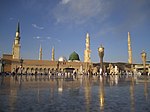This article needs additional citations for verification. (August 2023) |
| Tomb of Seyed Alaeddin Husayn | |
|---|---|
آرامگاه سَیِّد عَلَاء ٱلدِّیْن حُسَیْن | |
 | |
| Religion | |
| Affiliation | Twelver Shia Islam |
| Location | |
| Location | Shiraz, Fars province, Iran |
| Geographic coordinates | 29°36′19.1″N 52°32′55.2″E / 29.605306°N 52.548667°E |
| Architecture | |
| Style | Safavi Iranian architecture |
| Specifications | |
| Dome(s) | 1 |
| Minaret(s) | 2 |
The tomb of Sayyid ʿAlāʾed-Dīn Ḥusayn (Persian: آرامگاه سَیِّد عَلَاء ٱلدِّیْن حُسَیْن) is a shrine in south-east Shiraz, Iran.[1][2] Constructed in the 10th century of the Islamic calendar, the mausoleum houses the remains of Sayyid Ala'ed-Din Husayn, son of Imam Musa al-Kazim, and brother of Sayyid Ahmad (whose shrine is also in Shiraz).[2]
On account of the instability of the soil, and the earthquakes that occurred in Shiraz, this building suffered considerable damage, and a part of the dome, which had last been repaired by the late Mirza Abu'l-Hasan Moshiro'l-molk, gave way, and was threatened with collapse, and in spite of repairs, and much reinforcement, and subsequently, the threat of dissolution increased daily, until in the year 1950 the dome was taken down by the Fars Department of Education. Then a dome of less weight, with an interior iron structure, was prepared, and it was placed in position in 1952.
The Mausoleum of Sayyid Husayn was registered on 20 December 1937, under Number 307 in the list of the historical monuments of Iran.
-
The dome
-
View at night
See also
[edit]References
[edit]- ^ "Iranshahr". Encyclopedia of Iranian Architectural History. 19 May 2011. Archived from the original on 2018-11-25. Retrieved 2023-05-22.
- ^ a b "Seyed Ala-edin Hossein Shrine". itto.org. Retrieved 31 July 2019.
External links
[edit]











